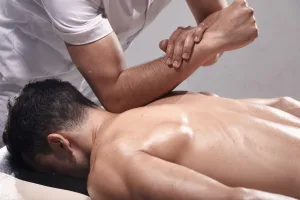By Joan Hannant, Founder & CEO of The Soma Institute
Massage therapy, a practice as ancient as it is therapeutic, combines the art of touch with a deep understanding of the human body to promote healing, relaxation, and wellness. At The Soma Institute, we believe in demystifying the process of massage to highlight its benefits and the thoughtful approach behind every technique. This post delves into the anatomy of a massage, explaining the why and the how of what happens during a session.
Initial Consultation and Assessment
The journey of a massage session begins long before the first touch. A typical massage starts with an initial consultation and assessment. This stage is crucial for the therapist to understand the client's medical history, current conditions, and specific needs or concerns. It sets the foundation for a tailored massage experience, ensuring that the techniques and approaches used are both safe and effective.
Creating a Customized Plan
Based on the initial assessment, the therapist creates a customized plan for the session. This plan considers the client's goals, whether it's relieving muscle tension, improving circulation, reducing stress, or addressing specific pain points. The therapist decides on the types of massage techniques to use, the areas of the body to focus on, and the intensity and pace of the session.
The Warm-Up Phase
As the actual massage begins, the therapist typically starts with a warm-up phase. Gentle, sweeping strokes known as effleurage are used to warm the muscles, enhance blood flow, and prepare the body for deeper work. This phase helps relax the client, making the muscles more receptive to therapeutic techniques.
Core Massage Techniques
Following the warm-up, the therapist employs a variety of techniques tailored to the client's needs. Techniques like kneading (petrissage), friction, and tapping (tapotement) target deeper muscle layers, addressing knots, tension, and alignment issues. The therapist's expertise in anatomy is evident as they navigate the body's musculature, applying pressure and movements that stimulate healing, release tension, and promote relaxation.
The Cool-Down Phase
After addressing specific issues and working through the body's regions as planned, the session gradually transitions into the cool-down phase. Similar to the warm-up, this phase involves lighter, soothing strokes to help the body ease back from the deep work, encouraging a state of relaxation and integrating the therapeutic benefits of the massage.
Post-Massage Recommendations
The session concludes with a brief discussion where the therapist provides post-massage care recommendations. This may include hydration tips, stretching exercises, or advice on how to maintain the benefits of the massage. It's also an opportunity for feedback and planning future sessions based on the client's therapeutic journey.
Understanding the anatomy of a massage illuminates the careful consideration and expertise behind every session. At The Soma Institute, our approach is rooted in a deep understanding of the human body and the healing power of touch. Each massage is a journey tailored to the individual, reflecting a commitment to wellness, healing, and the art of massage therapy.


